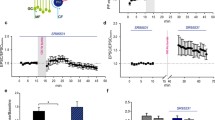Abstract
Cerebellar long-term depression (LTD) is induced by repetitive pairing of both synaptic inputs provided by climbing fibers (CFs) and parallel fibers (PFs), especially when CF stimulation followed by burst of PFs. Metabotropic glutamate receptor type 1 (mGluR1)-dependent signaling in Purkinje cells is critically involved in the induction of cerebellar LTD. Signaling pathway of mGluR1 has two limbs: one is IP3 receptor-mediated Ca release from intracellular Ca store and the other is activation of transient receptor potential canonical (TRPC) channels. Here, we hypothesized that TRPC3, which is reported to be responsible for mGluR1-evoked slow currents, mediates the induction of the cerebellar LTD. Purkinje cells were loaded with antibodies which act against a cytoplasmic epitope of TRPC3 channels, acting as a specific antagonist of TRPC3. About 30 min after achieving a whole-cell configuration, mGluR1-evoked slow currents were significantly reduced; a possible cause of this time delay might be the diffusion time course from patch pipette to the dendrite site of mGluR1 activation. Taking this delay into consideration, we next attempted to induce cerebellar LTD by pairing PFs and CF. It was found that cerebellar LTD was hindered in the presence of TRPC3 antibodies. Taken together, our data suggest that TRPC3 activation may be essential for the induction of LTD in cerebellar Purkinje cells.

Similar content being viewed by others
References
Albert AP, Pucovsky V, Prestwich SA, Large WA. TRPC3 properties of a native constitutively active Ca2+-permeable cation channel in rabbit ear artery myocytes. J Physiol-London. 2006;571:361–9.
Alvarez J, Coulombe A, Cazorla O, Ugur M, Rauzier JM, Magyar J, et al. ATP/UTP activate cation-permeable channels with TRPC3/7 properties in rat cardiomyocytes. Am J Physiol Heart Circ Physiol. 2008;295:H21–8.
Blair NT, Kaczmarek JS, Clapham DE. Intracellular calcium strongly potentiates agonist-activated TRPC5 channels. J Gen Physiol. 2009;133:525–46.
Canepari M, Auger C, Ogden D. Ca2+ ion permeability and single-channel properties of the metabotropic slow EPSC of rat Purkinje neurons. J Neurosci. 2004;24:3563–73.
Daniel H, Levenes C, Crepel F. Cellular mechanisms of cerebellar LTD. Trends Neurosci. 1998;21:401–7.
Doi T, Kuroda S, Michikawa T, Kawato M. Inositol 1,4,5-trisphosphate-dependent Ca2+ threshold dynamics detect spike timing in cerebellar Purkinje cells. J Neurosci. 2005;25:950–61.
Hartmann J, Dragicevic E, Adelsberger H, Henning HA, Sumser M, Abramowitz J, et al. TRPC3 channels are required for synaptic transmission and motor coordination. Neuron. 2008;59:392–8.
Hoang CJ, Khodakhah K. Calcium dependence of Purkinje cell inositol trisphosphate (IP3)-evoked calcium release in situ. Biophys J. 2004;86:241A–A.
Ito M, Sakurai M, Tongroach P. Climbing fiber induced depression of both mossy fiber responsiveness and glutamate sensitivity of cerebellar Purkinje cells. J Physiol-London. 1982;324:113–34.
Kim SJ, Kim YS, Yuan JP, Petralia RS, Worley PF, Linden DJ. Activation of the TRPC1 cation channel by metabotropic glutamate receptor mGluR1. Nature. 2003;426:285–91.
Linden DJ, Connor JA. Long-term synaptic depression. Annu Rev Neurosci. 1995;18:319–57.
Okubo Y, Kakizawa S, Hirose K, Iino M. Cross talk between metabotropic and ionotropic glutamate receptor-mediated signaling in parallel fiber-induced inositol 1,4,5-trisphosphate production in cerebellar Purkinje cells. J Neurosci. 2004;24:9513–20.
Schmolesky MT, Weber JT, De Zeeuw CI, Hansel C. The making of a complex spike: ionic composition and plasticity. In: Highstein SM, Thach WT, editors. Cerebellum: recent developments in cerebellar research. New York: Wiley. pp. 359–390.
Tanaka K, Khiroug L, Santamaria F, Doi T, Ogasawara H, Ellis-Davies GCR, et al. Ca2+ requirements for cerebellar long-term synaptic depression: role for a postsynaptic leaky integrator. Neuron. 2007;54:787–800.
Wang SSH, Denk W, Hausser M. Coincidence detection mediated by supralinear calcium signals in dendritic spines of cerebellar Purkinje cells. Biophys J. 2000;78:15a–a.
Acknowledgments
This work was supported by the National Research Foundation of Korea grant funded by the Korean Government (2009-0080939 and 2011-0030737).
Conflict of interest
The author declares that he has no competing personal or financial interest.
Author information
Authors and Affiliations
Corresponding author
Rights and permissions
About this article
Cite this article
Kim, S.J. TRPC3 Channel Underlies Cerebellar Long-Term Depression. Cerebellum 12, 334–337 (2013). https://doi.org/10.1007/s12311-013-0455-1
Published:
Issue Date:
DOI: https://doi.org/10.1007/s12311-013-0455-1




